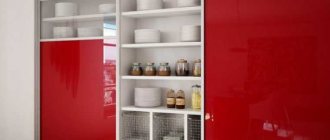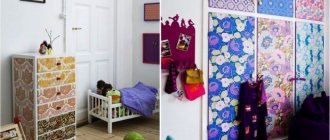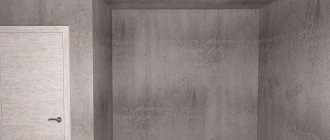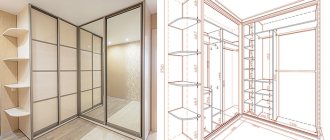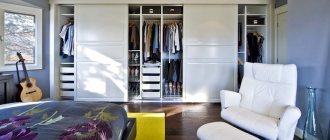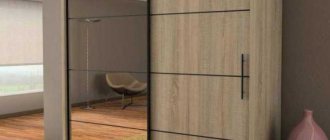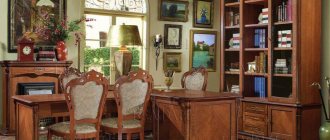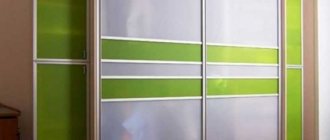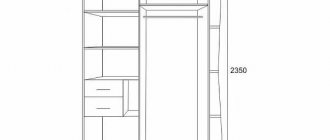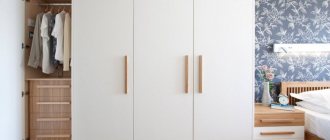Hello visitors to the site “Secrets of the Master”! Quite recently, in the article “Calculation and assembly of doors for a wardrobe”, I promised to talk about some methods for independently finishing cabinet facades. As you know, the main and most common filling of a sliding wardrobe system is a mirror or glass. And how this mirror or glass is processed will subsequently affect the overall appearance of any wardrobe, i.e. no matter how bizarre its geometry is in shape, the main advantage and beauty is still the façade (face)!
In fact, there are quite a lot of processing methods. From the simplest to the most complex, high-tech and costly. I think there is no point in talking about everyone, because not everyone will be able to process glass/mirror with sandblasting or a special alkaline suspension, engraving or silk-screen printing at home. Therefore, we will consider a couple of options for the simplest and at the same time quite beautiful decoration of wardrobe doors, which any craftsman can do independently.
Brushing
The easiest way to update an old cabinet is, oddly enough, by aging it. This type of furniture is especially good in luxurious classic interiors, Provence, loft and any other styles that tend to be retro.
To make scuffs look natural, choose the right places for them. Furniture gets worn down most quickly where it bears a load or is constantly touched: edges, corners, handles, tabletops, protruding relief.
Mechanical abrasions are created using brushing technology: the surface is treated with a hard metal brush, which removes paint and soft fibers. The technology is good for cabinets made of larch, pine, ash or oak.
Craquelure
Craquelure is the creation of a fine mesh of cracks on a surface using paint and a special varnish. It comes in two types: one-step - when the base or bottom layer directly peeks out from under the cracks of the paint; two-step - when under the craquelure there is another decorative coating or image.
In the simplest technology, the surface of the cabinet is first coated with a dark pigment, followed by colored or contrasting paint. And after drying, a craquelure varnish is applied, which provokes cracking. This option is suitable not only for wood, but also for cabinets made of any other materials.
Leave your mark
A great way to add contrast to a neutral closet palette is to use dark wood on the cabinet doors, creating a sort of crosshair pattern across multiple cells. For those who like the “X” pattern, such door decor will help, among other things, to ventilate items of clothing in closets - a thin fabric matching the color is simply attached to the wooden frames on the inside.
The cabinets pictured here use silk fabric in a neutral shade, but you can use brighter colors to lift the mood and give a more positive vibe to your closet.
Elegant abrasions
If brushing is too rough for your taste, there are more elegant aging techniques. Pay attention to this one if your interior is designed in Provence, boho or shabby chic style.
First, colored paint of a rich or pastel shade is applied to the surface - but always noticeable. After drying, it is thickly rubbed with paraffin or wax, and then a second layer of light paint is applied.
The wax is removed with regular sandpaper, and the bottom layer appears under the light coating. Delicate aging looks especially good in milky, beige, cream, olive, lavender, linen, pistachio and soft pink bases.
Accentuate your cabinets
You can make your closet an accent element of your interior. Use the well-known method of artificially aging wooden furniture - walnut wood looks antique if it is partially treated with light plaster.
In the bedroom image shown in the photo, the closet doors do not reach the floor, touching the snow-white panel, placed specifically to give the closet a more built-in look. Such a cabinet looks great against the background of walls decorated with decorative plaster, especially if the bedroom is designed in one of the country, Provence or shabby chic styles.
splashing
You can radically transform old furniture with ordinary decorative painting. Moreover, you don’t have to be able to draw to do this, because now abstraction, geometry and simplicity are in fashion.
A bright and creative accent in a modern interior will be an artistically splattered cabinet, as if it had just come from a painter’s studio. You will only need brushes, paints, water and newspaper or oilcloth to cover your work area.
Choose the spraying technology that you like best: just shake the brush onto the surface, paint with a toothbrush or toothpick, knock small drops from a wide brush. Until the paint dries, the result can always be corrected, especially since negligence here is a trick, not a mistake. Finally, varnish the cabinet to preserve your efforts.
Glaze
Glazing is another artistic technique, which boils down to the fact that the bottom layer of paint is visible through the translucent top one. The result is complex iridescent shades that play interestingly in the light.
The advantage of technology is that you can use almost any paint: oil, acrylic, watercolor, even strong tea. Dilute the acrylic with water to the desired shade and consistency and apply it with a sponge or synthetic brush. Glazing does not imply a dense, uniform coating; in fact, it is just tinting.
Staining
Stain is a tinting liquid that allows you to change the shade of wood, but completely preserve its texture. Apply it strictly parallel to the fibers, and paint over it with several layers of varnish or pearlescent glaze coating.
Soft fibers absorb the coloring composition more strongly, and from dense fibers it is washed off naturally. If you want to make the texture even more expressive, repeat the process several times. In order not to miss the result, first try the stain on that part of the cabinet where it is not visible.
Decoupage
Simple and affordable technology with a minimum number of tools and consumables has won the love of decorators around the world. In fact, this is almost an applique, for which paper napkins with drawings or special blanks are suitable.
Thoroughly clean and level the base so that the surface is completely smooth. If you are decorating a metal or glass shelf, wash and degrease it.
If necessary, you can first paint the cabinet with acrylic paint, but then wait until it is completely dry. Then apply a weak solution of PVA with water to the surface and place a top layer of patterned napkins on it. The whole thing is covered again with diluted PVA, and after drying, with a transparent varnish for smoothness and durability.
Patination
Patina is a characteristic antique coating that occurs when bronze or copper oxidizes. Its natural color is greenish-brown, but other options are used in decoration, including colored ones.
Apply bitumen varnish to the base and immediately wipe the surface so that it remains only in relief and recesses. And on top, coat the cabinet with a special shellac varnish, which at the same time provides resistance to scratches and damage.
Shellac varnish itself gives the surface a tone of old copper or gold. At the same time, it emphasizes the wood texture well, so it is often used to patina wooden furniture on its own.
Acrylic patina is ordinary diluted acrylic paint of a suitable shade. It is spilled in the same way on the raised areas, and all excess is wiped off with a clean rag.
Wax patina is a separate composition that is rubbed over the surface, giving it a tint and a characteristic satin sheen.
Chemical patina looks the most natural, because it simply speeds up natural processes hundreds of times. Paint the cabinet with paint containing fine metal particles and apply a special oxidizing agent on top.
Wardrobe design options
- home
- Useful tips
- Wardrobe design options
The more we settle into our apartment, the more personal things accumulate there. It is most convenient to store things in spacious wardrobes, but they do not always fit into the interior of our home. But, we can decorate boring and bulky furniture by creating beautiful decor. There are many ways to transform an unremarkable facade and make the design of a wardrobe unique and irresistible.
1. Sliding wardrobes with photo printing. Special printers, which can be purchased everywhere, are capable of printing photographs on any surface. You can choose any image that best matches the decor of your room and apply it to your wardrobe doors using large format printing techniques. Some people prefer to have photographs they have taken on the surface. The result is exclusive images that only you will have. Thus, a wardrobe with your own photograph (photo printing) is only your unique and inimitable creativity.
2. Sliding wardrobes with stained glass windows. One of the least expensive ways to give an unusual design to a sliding wardrobe is to use a special stained glass film, which can have different colors and patterns. Typically, such a film is self-adhesive and gluing it is not difficult. In addition to decorative functions, it also protects the surface of furniture from scratches and damage. Some films imitate stained glass, which undoubtedly adds elegance to any room. If desired, you can easily change the design of the wardrobe doors by gluing a film with a different pattern.
3. The most difficult method is laying mosaics, but the result can exceed all expectations. Using glass elements, elegant designs are created, which makes the appearance of the facade original and charming.
4. If the wardrobe doors are glass, then they can be sandblasted or frosted. As a result of this processing, multi-level patterns are obtained that give the interior relief and volume. Sandblasting usually requires special skills, so it is better to invite a specialist. But you can frost glass or mirror yourself. You can apply a design using a stencil and a special paste that makes the top layer velvety and matte.
5. Using the fusing technique, you can also create a masterpiece on the surface of a wardrobe. To apply a design, several glasses of different colors are taken and heated. The glass is sintered and a pattern is obtained that is very similar to stained glass. The resulting pattern is subsequently glued to the surface of the cabinet using self-adhesive film.
6. Stained glass painting helps to create magnificent patterns that will give your home a royal look. But in order to carry out such a design, you must be able to use silicate paints, brushes and special tools. You can also use stencils that are attached to the doors. Once the design is applied, the stencils can be removed. As a result, there will be a real stained glass picture on the door of your wardrobe and the design of the wardrobe will take on an expensive look.
Etching
Etching is a more complex chemical process than staining, so it requires careful preparation and selection of reagents. But this technology is good for cabinets made of hardwood. This way you can give them a rich, deep shade and emphasize the texture.
The simplest home recipes use decoctions of leaves, bark, tea, coffee, and potassium permanganate. But more effective are chemical components that can be purchased immediately with instructions for application and indicating the exposure time for different types of wood.
For example, 1% copper sulfate will help give oak a brown tint, 1% iron sulfate will give it a gray-lilac tint, and 4-5% iron will help give it a blue-black hue. You can paint a birch dark red with zinc sulfate, and greenish-yellow with potassium chromium.
Calcium chloride gives the coffee shade to light rocks, and Epsom salt gives the unusual purple color. And different combinations of these reagents create olive, lilac and golden tones.
Dry brush
Dry brushing is another technique that decorators learned from painters for elegantly distressing old cabinets for classic interiors. Take a little paint onto a flat synthetic brush, wipe off the excess on a rag or paper, and then brush over the base.
Do not press too hard, but go lightly around corners, joints and protruding parts. The brush hairs do not leave continuous lines, and the result is not a dense coating, but as if scratched.
Epoxy resin
Epoxy resin hardens quickly in open air and creates a beautiful translucent coating. By itself, it gives a golden or amber tint or creates the effect of glass or ice.
Deep cracks or noticeable defects on the surface of the cabinet can be filled with colored sand, small shells or any other decorations - and filled with resin on top. And small cracks will literally come to life if you add luminescent powder to the epoxy.
Add ventilation to cabinets
If you use a wood louvre design at the top of cabinet doors, you allow air to circulate in the space around the cabinets. This is very convenient and practical, especially for the southern regions of the country.
The photo shows a design project for a bedroom in a Mexican house. The doors were made from local wood sourced from the forests of Cancun. In the design of this built-in wardrobe, the designers decided to use a mirror insert in the arched part to create the illusion of refraction of the space of the room.
Self-adhesive film
If you don’t want to bother with paint, varnish and resin, there is an even simpler solution - decorative film. The stores offer many collections, from imitations of other materials to photo printing, textured, luminous and mirror coatings.
First, mark the film and cut it, and then glue it like tape, slowly and carefully pressing it to the base and expelling the bubbles. The main nuance is to carefully level the surface of the cabinet in advance, otherwise the film will highlight all the defects.
Stay within your budget
If you have to arrange a really large dressing room with several closets, then it is important not to go beyond the amount that you initially planned. As an option, you can use ready-made solutions for dressing room furniture from Ikea.
This is a visually attractive and practical option for decorating the fronts of your cabinets, which will not ruin the family budget.
Stencils
If you still want to paint a closet, but lack the skills, use stencils. You can print and cut them yourself or purchase them ready-made at an art store.
Surface preparation is the same as for any other painting: stripping, sanding, base coat. Apply light markings on top with a pencil so that the drawing does not move while working. Secure the stencil to the surface with masking tape to prevent it from fidgeting - and start painting.
If you want, take paint in a can, but then take care of additional surface protection. Instead of stencils, you can use old tulle, unnecessary openwork fabric and any other suitable materials.
Use the garage door principle
If you have a narrow closet or little space in the bedroom to accommodate swing doors (they require at least a meter of free space to open them), try large “garage” doors on slides.
A large door like in a garage or shed can open only a closet or the entire room, depending on the position. In a snow-white design, such a door will not look heavy and can bring a touch of rural life to the decor of your room.
Upholstery
An interesting and unusual decoration for an old cabinet is upholstery with a different material. But this should be the most ordinary cabinet of a simple shape and without relief decoration. Instead of stained fabric that cannot be removed, use dermantin, leatherette and their variations for upholstery.
Regular glue is suitable for attaching the canvas - the main thing is that there are no bruises or air bubbles. Decorate the edges, corners, ends and other areas with decorative nails and rivets. This type of finishing will take a lot of time, but it will fit luxuriously into English interiors or lofts.
How to stick photo printing on glass yourself?
I already told you in the article “3D photo printing in the interior” that one of the latest popular trends in interior design and furniture facade design is 3D photography. Sliding wardrobes with 3D photo printing and furniture with photo printing will make the design of any room unique. The technology is as follows: Any image is printed on synthetic paper using a special wide-format printer. For example, . This paper is self-adhesive (very similar to regular self-adhesive, only thicker), which comes in rolls 1000 mm wide, and the length depends on how many doors there are. There are sizes and more. Please note, in order to order 3D photo printing, you need to know the exact dimensions of the glass that will fill the frame of the sliding doors. For example. The overall size of one door is 2260×907 mm. The glass for such a door, based on calculations, should be 2198 × 872 mm and a thickness of 4 mm.
For work we will need:
- Scissors.
- Wallpaper knife.
- Plastic wallpaper spatula (“wing”) for smoothing wallpaper.
- Sprayer for household water.
- Clean rag.
Let's get to work.
✓Cut off with a slight overlap (3-5 mm per side) the excess white margins of the photo printing sheet.
✓Carefully, so as not to cut yourself, place the glass on the table. ✓We wipe the glass with a rag and detergent to remove streaks and stains.
style=”display:inline-block;width:336px;height:280px” data-ad-client=”ca-pub-3518738935631683″ data-ad-slot=”6877683473″>
Now comes a very important technological moment. IMPORTANT!
- Before applying the sticker, the glass must be sprayed with water . This is the main condition. If you don’t do this, you simply won’t smooth out the paper and ruin the material.
- You need to glue with the image facing down, i.e. sticky base.
✓Smooth the canvas efficiently and accurately using a plastic pressing wallpaper spatula (“wing”).
Advice. It’s better to do the work together – it’s much more convenient.
✓Use a wallpaper knife to cut off the excess along the contour of the glass.
All glass with photo printing is ready.
Now we assemble the frame of the future door for the wardrobe. ✓We put a silicone seal around the perimeter of the glass ends.
✓Insert the upper and lower aluminum profile. ✓Insert the left and right posts. ✓We fasten the entire frame with self-tapping screws, which come complete with rollers. ✓Install the rollers (top/bottom). I described in detail how to collect in this article.
That’s it – the door assembly is ready.
Applying a photo to a wardrobe gives you virtually unlimited scope for your imagination. The choice of subjects is truly limitless, and the material for applying the image will only emphasize and strengthen your idea.
So, by decorating the doors of sliding wardrobes with photo printing, for example, with an image of lips or palm trees, as in my case, you will create a special atmosphere that will excite and lift your spirits. By the way, in principle, using this method you can update the facade of your old wardrobe. ✓Only for this you need to disassemble the door frame and remove the chipboard filling (10 mm). ✓Try on its size. ✓Order glass (4 mm) according to its dimensions minus 2 mm in height and width for sealing. ✓Order your favorite photo print according to the glass size. ✓Buy a seal. ✓And do everything as I described above.
DIY old cabinet decor - photo ideas
These are not all the options that you can easily implement with your own hands. After all, an old cabinet has nothing left to lose, so don't limit your imagination. And we offer a few more ideas for this!
Surface decoration
There are many DIY ways to update your cabinets. The most popular, even today, is painting cabinet furniture. The decor of a sliding wardrobe or a standard version simply cannot do without painting, and bright colors will help the old product sparkle with new colors. In order for the paint to last a long time and look beautiful, you need to follow the rules:
- Preferably use acrylic paints;
- sand the surface well;
- eliminate in advance any imperfections that become visible after painting.

